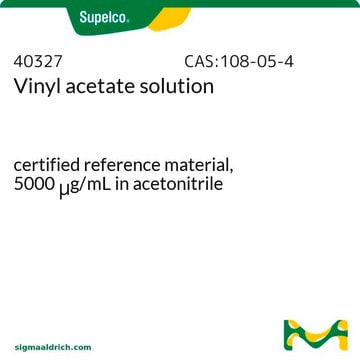48486
Vinyl acetate
analytical standard
Synonym(s):
Acetoxyethylene
About This Item
Recommended Products
grade
analytical standard
Agency
EPA 8240,8260
vapor density
3 (vs air)
vapor pressure
88 mmHg ( 20 °C)
CofA
current certificate can be downloaded
autoignition temp.
801 °F
expl. lim.
13.4 %
packaging
pkg of 1000 mg
technique(s)
HPLC: suitable
gas chromatography (GC): suitable
refractive index
n20/D 1.395 (lit.)
bp
72-73 °C (lit.)
mp
−93 °C (lit.)
density
0.934 g/mL at 25 °C (lit.)
application(s)
cleaning products
cosmetics
environmental
food and beverages
personal care
petroleum
format
neat
storage temp.
2-8°C
SMILES string
CC(=O)OC=C
InChI
1S/C4H6O2/c1-3-6-4(2)5/h3H,1H2,2H3
InChI key
XTXRWKRVRITETP-UHFFFAOYSA-N
Looking for similar products? Visit Product Comparison Guide
General description
Application
Other Notes
Signal Word
Danger
Hazard Statements
Precautionary Statements
Hazard Classifications
Acute Tox. 4 Inhalation - Aquatic Chronic 3 - Carc. 2 - Flam. Liq. 2 - STOT SE 3
Target Organs
Respiratory system
Storage Class Code
3 - Flammable liquids
WGK
WGK 2
Flash Point(F)
17.6 °F - closed cup
Flash Point(C)
-8 °C - closed cup
Personal Protective Equipment
Choose from one of the most recent versions:
Already Own This Product?
Find documentation for the products that you have recently purchased in the Document Library.
Customers Also Viewed
Our team of scientists has experience in all areas of research including Life Science, Material Science, Chemical Synthesis, Chromatography, Analytical and many others.
Contact Technical Service
















